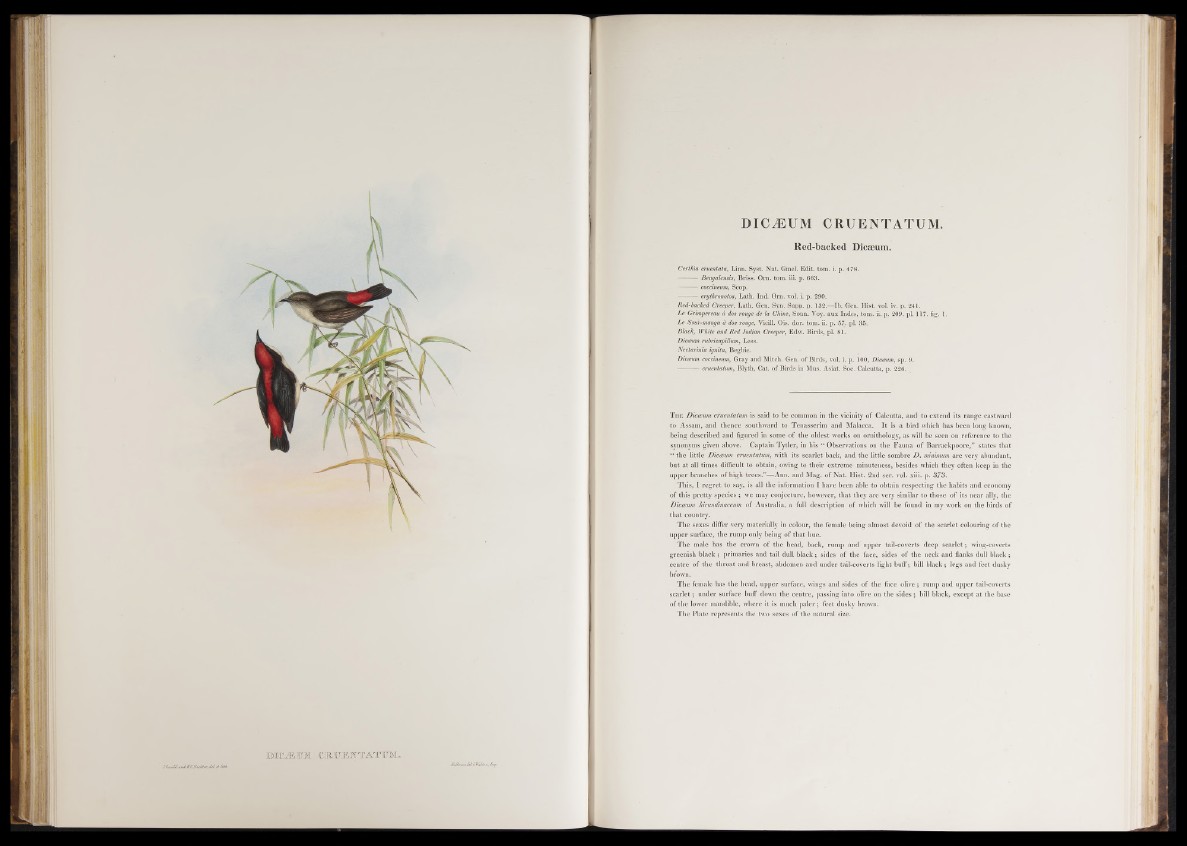
BICJEITM CIULTENTATIIM..
D I C T U M c r u e n t a t u m .
Red-backed Dicaeum.
Certhia cruentata, Linn. Syst. Nat. Gmel. Edit. tom. i. p. 478.
Bengalcnsis, Briss. Orn. tom. iii. p. 663.
— coccineum, Scop.
erythronotos, Lath. Ind. Om. vol. i. p. 290.
Red-backed Creeper, Lath. Gen. Syn. Supp. p. 132.—lb. Gen. Hist. vol. iv. p. 241.
Le Grimpereau d dos rouge de la Chine, Sonn. Voy. aux Indes, tom. ii. p. 209. pi. 117. fig. 1.
Le Soui-manga d dos rouge, Vieill., Ois. dor. tom. ii. p. 67. pi. 36.
Black, White and Red Indian Creeper, Edw. Birds, pi. 81.
Diceeum rubricapillum, Less.
Nectarinia ignita, Begbie.
Diceeum coccineum, Gray and Mitch. Gen. of Birds, vol. i. p. 100, Diceeum, sp. 9.
cruentatum, Blyth, Cat. of Birds in Mus. Asiat. Soc. Calcutta, p. 226.
T h e Diceeum cruentatum is said to be common in the vicinity of Calcutta, and to extend its range eastward
to Assam, and thence southward to Tenasserim and Malacca. I t is a bird which has been long known,
being described and figured in some of the oldest works on ornithology, as will be seen on reference to the
synonyms given above. Captain Tytler, in his “ Observations on the Fauna of Barrackpoore,” states that
“ the little Diceeum cruentatum, with its scarlet back, and the little sombre D. minimum are very abundant,
but at all times difficult to obtain, owing to their extreme minuteness, besides which they often keep in the
upper branches of high trees.”—Ann. and Mag. of Nat. Hist. 2nd ser. vol. xiii. p. 373.
This, I regret to say, is all the information I have been able to obtain respecting the habits and economy
o f this pretty species ; we may conjecture, however, that they are very similar to those of its near ally, the
Diceeum hirundinaceum o f Australia, a full description of which will be found in my work on the birds of
that country.
The sexes differ very materially in colour, the female being almost devoid of the scarlet colouring of the
upper surface, the rump only being of that hue.
The male has the crown of the head, back, rump and upper tail-coverts deep sc a rle t; wing-coverts
greenish black ; primaries and tail dull black; sides of the face, sides o f the neck and flanks dull black ;
centre o f the throat and breast, abdomen and under tail-coverts light buff; bill black; legs and feet dusky
brown.
The female has the head, upper surface, wings and sides of the face olive; rump and upper tail-coverts
sc arlet; under surface buff down the centre, passing into olive on the sides ; bill black, except at the base
of the lower mandible, where it is much p a le r; feet dusky brown.
The Plate represents the two sexes of the natural size.